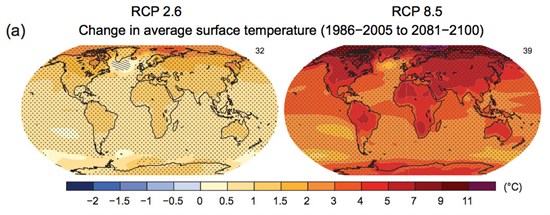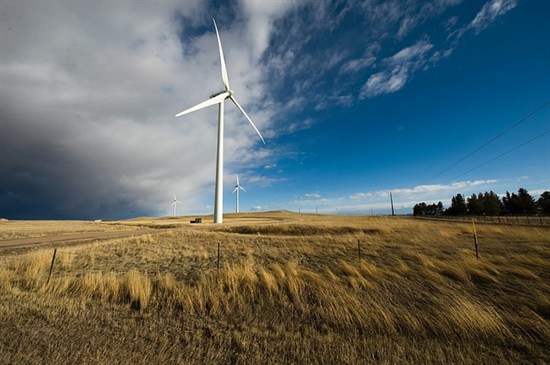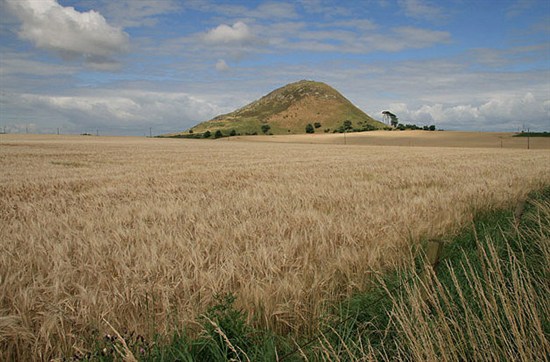Roz Pidcock
14.04.2014 | 1:10pmCutting emissions, ramping up renewable energy, adapting to a new way of life and sucking carbon dioxide out of the air: recent reports from the Intergovernmental Panel on Climate Change (IPCC) appear to offer a number of ways to limit the scale and seriousness of climate change.
Which are the real climate solutions, and which are pretty risky bets? Here’s what the IPCC says about what will and won’t work when it comes to fixing the climate.
The two degree target
What we can do to curb the impacts of climate change is the topic of the third in a series of recent reports from the IPCC. But when we talk about limiting climate change, what do we really mean?
The idea that we should avoid “dangerous” interference with the climate has been around for a while. But at the UN climate summit in Cancun in 2010, governments made the goal of keeping warming to no more two degrees Celsius above pre-industrial levels an official target.
The world has already warmed by 0.85 degrees over the industrial period and if emissions stay high, we’re on course for more like three to five degrees by 2100, the IPCC noted in its September report.
In other words, without efforts to reduce warming, we’re set to fall a long way short of the target.
 The IPCC’s RCP2.6 scenarios keep global average warming to within two degrees Celsius above pre-industrial levels (left). A business-as-usual sceanario would see a three to five degree rise by the end of the century, much higher in some regions. Temperatures in the map are relative to 1986-2005. Source: IPCC Working Group 1 report.
The IPCC’s RCP2.6 scenarios keep global average warming to within two degrees Celsius above pre-industrial levels (left). A business-as-usual sceanario would see a three to five degree rise by the end of the century, much higher in some regions. Temperatures in the map are relative to 1986-2005. Source: IPCC Working Group 1 report.
Two degrees is still possible, but it’ll be a huge challenge
The IPCC’s new report looks at many ways greenhouse gas emissions could evolve this century. Only pathways which see the concentration of greenhouse gases in the atmosphere stabilise at 430 to 480 parts per million give us a likely chance of staying below two degrees, the report says.
In calculations like these, greenhouse gas concentration is expressed as carbon dioxide equivalent (CO2eq), which is a way of including all greenhouse gases, not just carbon dioxide. In an IPCC context, the term “likely” refers specifically to a probability of 66 to 100 per cent.
In 2011, we’d already reached 430 ppm – and emissions are accelerating., the report notes. On current trends, the IPCC estimates we’d exceed 450 ppm by 2030.
But that’s not a foregone conclusion. It’s still possible to stay below two degrees, but only with rapid cuts to emissions. Globally, emissions need to come down by 40 to 70 per cent by 2050, and all the way down to zero by 2100, the report notes.
Low-carbon energy
Decarbonising the energy sector is a crucial part of lowering emissions, the report says.
The energy sector is responsible for about 35 per cent of global annual greenhouse gas emissions. A big part of the increase in emissions in the last decade has been a rise in the share of coal in the global energy mix, the report notes.
To keep within the two degree target, unabated fossil fuel burning would need to be almost completely phased out by 2100. The share of low carbon energy – which includes nuclear, wind, solar and bioenergy – would have to a triple or even quadruple by 2050, the IPCC says.

Low carbon energy includes wind, solar, nuclear, CCS and BECCS.
The report notes that while nuclear could play an increasingly large role in lowering emissions, a number of barriers exist to making it happen, including operational risks and public opinion.
Replacing coal plants with highly efficient gas plants could serve as a “bridge technology”, the report notes. But to be consistent with two degrees warming, gas production would need to peak and decline to below current levels by 2050, and decline further in the second half of the century.
Capturing carbon
The only way we could continue burning fossil fuels is with carbon capture and storage (CCS), the report says.
This is where technology is fitted to power stations to capture carbon dioxide as it escapes from the power station flues. The carbon-heavy emissions are collected and stored in underground rocks or disused mines.
But CCS is still in its infancy and is not yet up and running on a large scale, the report notes. So pinning too much hope on a largely untested technology could be a risky option. There’s also the risk of carbon dioxide leaking out from the rocks or during transportation, the report notes.
Is there a “Plan B”?
What if we move too slowly with mitigation? Is there a back up plan?
The IPCC says letting greenhouse gas concentrations temporarily ‘overshoot’ and then return to levels consistent with two degrees is a possibility.
The way the IPCC suggests this could be achieved is through attaching CCS technology to power plants burning biomass instead of fossil fuels, a process known as BECCS.
If plants, trees or crops are grown at the same time as they are burnt, BECCS could be “carbon negative”, meaning it removes carbon dioxide from the air.

Burning plants, trees or crops with CCS technology to capture the emissions is a form of low-carbon energy.
Almost all pathways consistent with two degrees include BECCS to some extent, the report says. But a number of factors make it difficult to assess how large BECCS’s role in mitigating climate change could be in reality, the report notes, such as the plant stock that’s used and whether land for growing food is converted to grow biofuel crops.
But relying on the availability of CCS is a risky option. What’s more, the longer we wait to act on emissions, the more likely we are to have to rely on such untested technology, the report notes.
Even if CCS technology becomes available on a very large scale, there are still limits to how much carbon we could emit. The IPCC says if greenhouse gases are allowed to rise above 530 ppm by 2050, it becomes unlikely even the use of BECCS would keep the two degree target in our sights.
Geoengineering, such as removing carbon dioxide directly from the air or deflecting sunlight back into space, are also largely untested. What’s more, they could bring serious side effects for ecosystems, the water cycle and food production, the IPCC notes.
A robust toolkit
The bottom line from the IPCC report is that the key to limiting climate change is to have a host of tools at our disposal. As EU climate commissioner Connie Hedegaard said:
“The report is clear: there really is no plan B for climate change. There is only plan A: collective action to reduce emissions now.”
Ramping up low carbon energy – including renewables, nuclear, fossil fuels with CCS and BECCS – is crucial but improving energy efficiency, reducing deforestation and changing behaviour to use less energy will help, the report says.
Adaptation is also needed alongside mitigation to soften the blow of impacts past emissions mean we can no longer avoid.
The IPCC doesn’t dictate policy – and so the new report is not a rule book. But the pathway to two degrees is clear enough. Now it’s up to governments worldwide to decide on the next steps.

